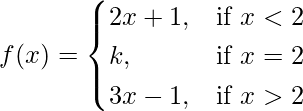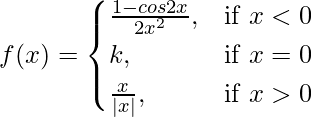Pregunta 31. Si  es continua en x = 2, encuentra k.
es continua en x = 2, encuentra k.
Solución:
Dado que,
Además, f(x) es continua en x = 2
Entonces, LHL = RHL = f(2) …..(i)
Ahora,
f(2) = k ……(ii)
Consideremos LHL,
……(iii)
Usando la ecuación (i), (ii) y (iii), obtenemos
k = 1/2
Pregunta 32. Si  es continua en x = 0, encuentra k.
es continua en x = 0, encuentra k.
Solución:
Dado que,
Además, f(x) es continua en x = 2
Entonces, LHL = RHL
Ahora,
⇒
⇒
⇒
⇒
⇒
⇒
⇒
⇒ -2 × 1 × (1 + 1) = k
⇒ k = -4
Pregunta 33. Extiende la definición de lo siguiente por la continuidad f(x) =  en el punto x = π.
en el punto x = π.
Solución:
Dado que,
Como sabemos que af(x) es continua en x = π si,
LHL = RHL = f(π) ……(i)
Consideremos LHL,
= (2/5) × (49/4) = 49/10
Así, de la ecuación (i) obtenemos,
f(π) = 49/10
Por lo tanto, f(x) es continua en x = π
Pregunta 34. Si f(x) =  , x ≠ 0 es continua en x = 0, entonces encuentra f(0).
, x ≠ 0 es continua en x = 0, entonces encuentra f(0).
Solución:
Dado que,
f(x) =
Además, f(x) es continua en x = 0
Entonces, LHL = RHL = f(0) ……(i)
Consideremos LHL,
De la ecuación (i) obtenemos,
f(0) = 1
Pregunta 35. Encuentra el valor de k para el cual  es continua en x = 0
es continua en x = 0
Solución:
Dado que,
Además, f(x) es continua en x = 0
LHL = RHL = f(0) …..(i)
f(0) = k
Consideremos LHL,
Así, de la ecuación (i) obtenemos,
k = 1
Pregunta 36. En cada uno de los siguientes, encuentre el valor de la constante k para que la función dada sea continua en el punto indicado:
(i)  en x = 0
en x = 0
Solución:
Dado que,
Además, f(x) es continua en x = 0
⇒
⇒
⇒
⇒ 2k 2 × 1 = 8
⇒ k2 = 4
⇒k = ±2
(ii)  en x = 1
en x = 1
Solución:
Dado que,
Además, f(x) es continua en x = 1
⇒
Ahora, al poner x – 1 = y, obtenemos
⇒
⇒
⇒
⇒
⇒
⇒ (-2/π) × (1/1) = k
⇒ k = (-2/π)
(iii)  en x = 0
en x = 0
Solución:
Dado que,
Además, f(x) es continua en x = 0
Consideremos LHL, en x = 0
Consideremos RHL en x = 0
Por lo tanto, no existe ningún valor de k para el cual la función sea continua en x = 0.
(iv)  en x = π
en x = π
Solución:
Dado que,
Además, f(x) es continua en x = π
Consideremos LHL
Consideremos la BSR
cosπ = -1
Como sabemos que f(x) es continua en x = π, entonces
⇒ kπ + 1 = -1
⇒ k = (-2/π)
(v)  en x = 5
en x = 5
Solución:
Dado que,
Además, f(x) es continua en x = 5
Consideremos LHL
= 5k + 1
Consideremos la BSR
= 10
Como sabemos que f(x) es continua en x = 5, entonces
⇒ 5k + 1 = 10
⇒ k = 9/5
(vi)  en x = 5
en x = 5
Solución:
Dado que,
Además, f(x) es continua en x = 5
Asi que,
f(x) = (x 2 – 25)/(x – 5), si x ≠ 5 & f(x) = k, si x = 5
⇒ f(x)= {(x – 5)(x+5)/(x-5)}, si x ≠ 5 & f(x) = k, si x = 5
⇒ f(x)= (x + 5), si x ≠ 5 & f(x) = k, si x = 5
Como sabemos que f(x) es continua en x = 5, entonces
⇒
⇒ k = 5 + 5 = 10
(vii)  en x = 1
en x = 1
Solución:
Dado que,
Además, f(x) es continua en x = 1
Consideremos LHL
Consideremos la BSR
= k
Como sabemos que f(x) es continua en x = 1, entonces
⇒ k = 4
(viii)  en x = 0
en x = 0
Solución:
Dado que,
Además, f(x) es continua en x = 0
Consideremos LHL
= 2k
Consideremos la BSR
= 1
Como sabemos que f(x) es continua en x = 0, entonces
⇒ 2k = 1
⇒ k = 1/2
(ix)  en x = 2
en x = 2
Solución:
Dado que,
Además, f(x) es continua en x = 2
f(x)=
, si x ≠ 2 & f(x) = k, si x = 2
⇒ f(x)=
, si x ≠ 2 & f(x) = k, si x = 2
⇒ f(x)=
, si x ≠ 2 & f(x) = k, si x = 2
⇒ f(x)= (x + 5), si x ≠ 2 & f(x) = k, si x = 2
Como sabemos que f(x) es continua en x = 2, entonces
⇒
⇒ k = 2 + 5 = 7
Pregunta 37. Encuentra los valores de a y b para que la función f dada por
 es continua en x = 3 y x = 5.
es continua en x = 3 y x = 5.
Solución:
Dado que,
Consideremos LHL en x = 3,
= 1
Consideremos RHL en x = 3,
= 3a + b
Consideremos LHL en x = 5,
= 5a + b
Consideremos RHL en x = 5,
= 7
Dado que f(x) es continua en x = 3 y x = 5, entonces
y
⇒ 1 = 3a + b …..(yo)
y 5a + b = 7 …….(ii)
Al resolver las ecuaciones (i) y (ii), obtenemos
a = 3 y b = -8
Pregunta 38. Si  . Demuestre que f es continua en x = 1.
. Demuestre que f es continua en x = 1.
Solución:
Dado que,
Asi que,
Consideremos LHL en x = 1,
= 1/2
Consideremos RHL en x = 1,
= 2 – 3 + 3/2 = 1/2
También,
f(1) = (1) 2 /2 = 1/2
IZD = LDH = f(1)
Por lo tanto, la f(x) es continua en x = 1
Pregunta 39. Discutir la continuidad de f(x) en los puntos indicados:
(i) f(x) = |x| + |x – 1| en x = 0, 1.
Solución:
Dado que,
f(x) = |x| + |x – 1|
Entonces, aquí comprobamos la continuidad de la f(x) dada en x = 0,
Consideremos LHL en x = 0,
Consideremos RHL en x = 0,
También,
f(0) = |0| + |0 – 1| = 0 + 1 = 1
IZD = LDH = f(0)
Ahora, comprobamos la continuidad de la f(x) dada en x = 1,
Consideremos LHL en x = 1,
= 1
Consideremos RHL en x = 1
= 1
También,
f(1) = |1| + |1 – 1| = 1 + 0 = 1
IZD = LDH = f(1)
Por tanto, f(x) es continua en x = 0, 1.
(ii) f(x) = |x – 1| + |x + 1| en x = -1, 1.
Solución:
Dado que,
f(x) = |x – 1| + |x + 1| en x = -1, 1.
Entonces, aquí comprobamos la continuidad de la f(x) dada en x = -1,
Consideremos LHL en x = -1,
Consideremos RHL en x = -1,
También,
f(-1) = |-1 – 1| + |-1 + 1| = |-2| = 2
IZD = LDH = f(-1)
Ahora, comprobamos la continuidad de la f(x) dada en x = 1,
Consideremos LHL en x = 1,
= 2
= 2
También,
f(1) = |1 + 1| + |1 – 1| = 2
IZD = LDH = f(1)
Por tanto, f(x) es continua en x = -1, 1.
Pregunta 40. Demuestra que  es discontinua en x = 0.
es discontinua en x = 0.
Solución:
Demuestre que
es discontinua en x = 0.
Prueba:
Consideremos LHL en x = 0,
Consideremos RHL en x = 0,
LHL ≠ RHL
Por tanto, f(x) es discontinua en x = 0.
Pregunta 41. Si  entonces cuál debería ser el valor de k para que f(x) sea continua en x = 0.
entonces cuál debería ser el valor de k para que f(x) sea continua en x = 0.
Solución:
Dado que,
Consideremos LHL en x = 0,
= k
Consideremos RHL en x = 0,
= k
Se da que f(x) es continua en x = 0.
IZD = LDH = f(0)
⇒
k puede ser cualquier número real.
Pregunta 42. ¿Para qué valor λ de es la función
 continua en x = 0 ? ¿Qué pasa con la continuidad en x = ±1?
continua en x = 0 ? ¿Qué pasa con la continuidad en x = ±1?
Solución:
Dado que,
Comprobar x = 0,
Por lo tanto, no hay valor de λ para el cual f(x) sea continua en x = 0.
Ahora para x = 1,
f(1) = 4x + 1 = 4 × 1 + 1 = 5
Por lo tanto, para cualquier valor de λ, f es continua en x = 1.
Ahora para x = -1,
f(-1) = λ(1 + 2)= 3λ
Por lo tanto, para cualquier valor de λ, f es continua en x=-1.
Pregunta 43. ¿Para qué valores de k la siguiente función es continua en x = 2?
Solución:
Dado que,
Tenemos,
Consideremos LHL en x = 2,
= 5
Consideremos RHL en x = 2,
= 5
También,
f(2) = k
Se da que f(x) es continua en x = 2.
LHL = RHL = f(2)
⇒ 5 = 5 = k
Por tanto, para k = 5, f(x) es continua en x = 2.
Pregunta 44. Sea  Si f(x) es continua en x = (π/2), encuentre a y b.
Si f(x) es continua en x = (π/2), encuentre a y b.
Solución:
Dado que,
Consideremos LHL en x = π/2
= 1/2
Consideremos RHL en x = π/2
= b/8 × 1
= b/8
También,
f(π/2) = un
Se da que f(x) es continua en x = π/2.
IZD = LDH = f(π/2)
Asi que,
⇒ 1/2 = b/8 = un
⇒ a = 1/2 y b = 4
Pregunta 45. Si la función f(x), definida a continuación, es continua en x = 0, encuentre el valor de k,
Solución:
Dado que,
Consideremos LHL en x = 0,
= 1 × 1
Consideremos RHL en x = 0,
También,
f(0) = k
Se da que f(x) es continua en x = 0,
IZD = LDH = f(0)
Asi que,
⇒ 1 = 1 = k
Por lo tanto, el valor requerido de k es 1.
Pregunta 46. Encuentra la relación entre ‘a’ y ‘b’ tal que la función ‘f’ definida por
 es continua en x = 3.
es continua en x = 3.
Solución:
Dado que,
Consideremos LHL en x = 3,
= 3a + 1
Consideremos RHL en x = 3,
= 3b + 3
Se da que f(x) es continua en x = 3,
LHL = RHL = f(3)
Asi que,
⇒ 3a + 1 = 3b + 3
⇒ 3a – 3b = 2
Por lo tanto, la relación requerida entre a y b es 3a – 3b = 2.
Publicación traducida automáticamente
Artículo escrito por rahulsharma1771996 y traducido por Barcelona Geeks. The original can be accessed here. Licence: CCBY-SA















